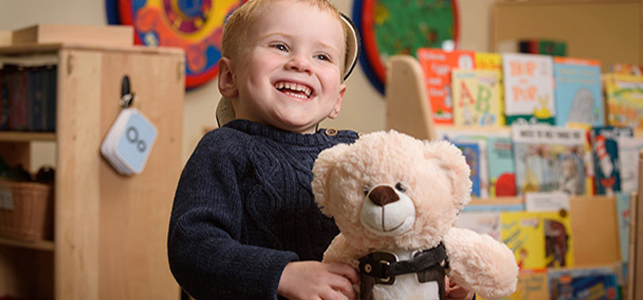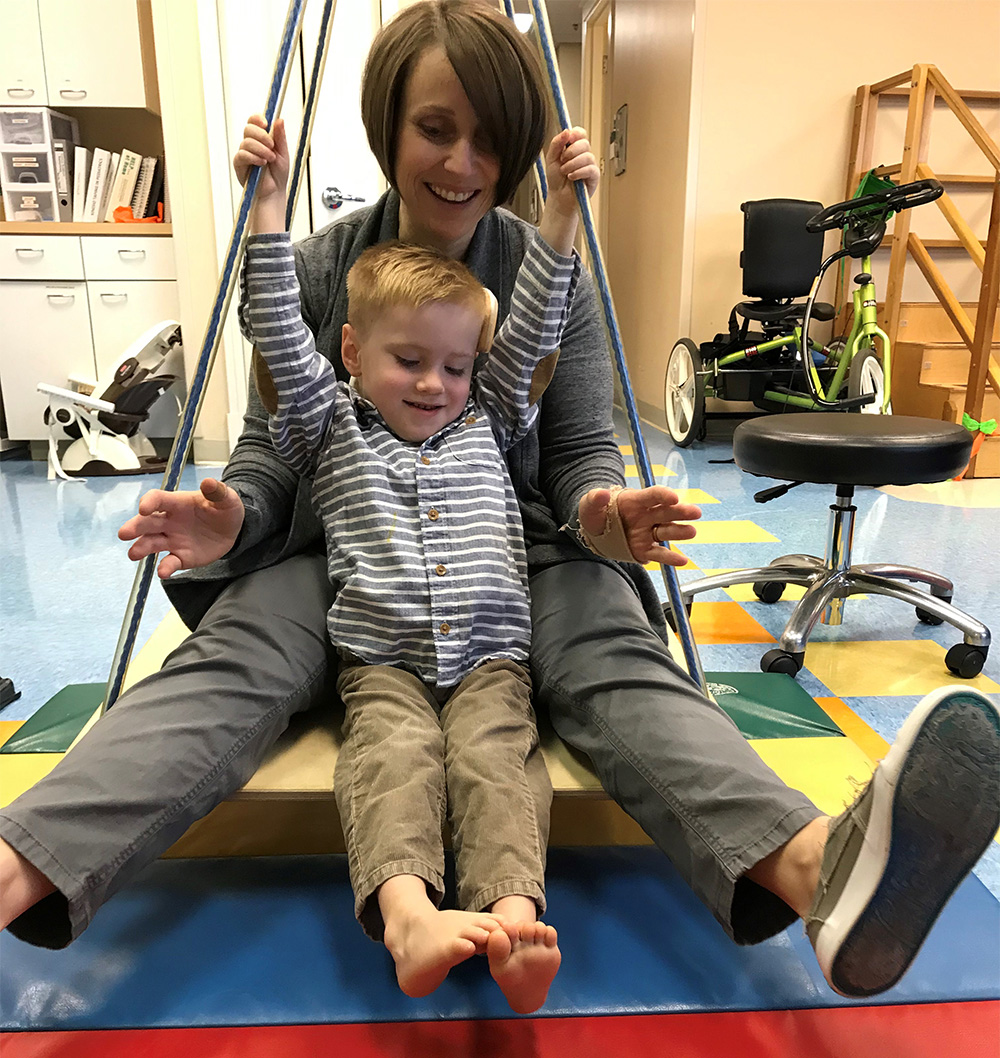Children's Emergency Department is now located in Children's Tower: 1001 E. Marshall Street.
Learn more
More than one specialist told Laura and Charles Portz that their son Caiden would likely need a complex spinal surgical procedure soon after he turned two.
But Caiden’s now 4, and he’s been able to hold off, defying the odds as he’s known to do.
Having more time before surgery has several benefits and an especially important one, according to his mom, is this: “If Caiden gets as much growth as possible before, the hardware will fit better in his bones.”
Physical therapy, a brace made just for him and, above all, this toddler’s super-resilient spirit helped his body to this point. “Caiden bounces back from whatever you throw at him,” physical therapist Lisa Bebko praises. “Like his brace – it’s awkward, but he wears it like a champ.”
Lisa began working with Caiden when he was five weeks old. He’d been referred for torticollis, a relatively common newborn condition relating to tight muscles on one side of the neck.
Newborns with torticollis typically tilt their head to one side and Caiden tended to tilt his to the left and bend his body that way too. Exercises to help loosen and strengthen Caiden’s tight neck muscles were part of their twice-weekly sessions and Lisa worked with Laura and Charles on ways to continue this at home.
More than once in their first few months working together, Lisa urged Caiden’s parents to have him re-evaluated. She was initially concerned by a popping sound in his shoulder area during certain exercises, then by the lack of improvement in his head tilt, despite a special torticollis collar and their combined efforts (“His parents follow thru with everything,” she says). As Caiden grew, Lisa noticed his left-side hip muscles tightening and other posture issues. The first evaluation did not change his diagnosis, but a second, when was three months old, looked more closely at his neck and upper back at Lisa’s urging. This told a very different story: congenital scoliosis.
“It was a complete shock,” Laura recalls. “For three months we’d been told it was all related to his muscles.”
Scoliosis refers to the vertebra in the spine forming a curve, rather than being straight. Large curves can damage joints, cause back pain and affect lung function. Scoliosis most commonly develops when a child goes through a growth spurt like puberty; much more rarely, it’s something a child is born with (congenital).
The x-ray, and an MRI imaging test soon after, showed that most all the vertebrae in Caiden’s neck were abnormal on the left side and that he has a 75-degree neck curve which is considered severe and in a range that requires surgery. Without supportive equipment, Caiden’s head tends to rest on his left shoulder. He also has a 40-degree curve in his thoracic spine (from the base of the neck to the lower back).
Congenital scoliosis is associated with problems with development before birth, and certain organs may also be affected. The MRI also showed that Caiden only has one kidney and several of his ribs are fused together, but his heart is not affected and his spinal cord is OK. He sees our specialists regularly to make sure his kidney continues to function well and that his lungs are functioning well too.
In the past few years, Laura and Charles traveled through much of the East Coast for consultations with doctors who specialize in this form of scoliosis. “It’s really rare and hard to correct because it’s so complex and because of its placement,” Laura says. The surgeons they’ve met have differing opinions on exact methods, but they do agree that surgery and physical therapy are needed, and that most children are not diagnosed as young as Caiden was but are treated unsuccessfully for torticollis much longer.
 Caiden’s condition is rare from a therapy standpoint as well, and for her part Lisa began researching and consulting with other therapists on the best ways to provide support. She continued to focus on stretching to keep soft tissues in affected areas – his skin, muscles and nearby connective tissue – flexible. “When joints are in one position for a long period of time, these tissues can shorten and shrink (tighten),” she explains. “You want to keep them flexible to keep from shortening. This helps them be able to continue to move well and also so they don’t have to do a skin graft or muscle release during surgery.”
Caiden’s condition is rare from a therapy standpoint as well, and for her part Lisa began researching and consulting with other therapists on the best ways to provide support. She continued to focus on stretching to keep soft tissues in affected areas – his skin, muscles and nearby connective tissue – flexible. “When joints are in one position for a long period of time, these tissues can shorten and shrink (tighten),” she explains. “You want to keep them flexible to keep from shortening. This helps them be able to continue to move well and also so they don’t have to do a skin graft or muscle release during surgery.”
Caiden’s favorite therapy activity is a ride-around stretch. He sits on Lisa’s lap on a wheeled stool and together they ride around to say “hi” to staff and guests. While he’s busy doing this, she gets a good stretch of his neck. One of the things she’s noticed in their travels together is that he’s quick to notice if someone isn’t happy and will always stop and check in about why. “He’s so kind. Not a lot of kids his age would do that. Caiden is just a really neat kid.”
When Caiden was around one, Lisa began working with an equipment specialist to create a brace would hold his head upright, his back straight and help his curves from worsening. They tried a few options and what ended up working is a brace that’s typically used for curves located higher up on the spine with a round headpiece added over the left side. “There was nothing already made like this,” Lisa remarks. “It was based on a design used by a girl from Minnesota who had a similar condition.”
The brace runs from Caiden’s lower back to the top of his neck. It holds his body in a position that helps keep his soft tissues more stretched and elongated so that during therapy they’re as ready as they can be for Lisa to stretch them to an ideal end range.
The brace also holds his head in an upright position, which is especially important as it reduces the risk of vision problems. “If your head tilts all the time, it starts to affect your vision. The horizon can begin to look crooked when your head is upright,” Lisa explains.
Caiden wears the brace throughout the day. “He does really well with it and never complains,” Laura says. This, along with his therapy, helps reduce related pain which has been helpful in holding off on surgery.
Caiden’s body tends to rotate to the right side due to his curves and he favors this side in his physical movements. In sessions, Lisa also helps him work toward a more straightforward and symmetrical body position and on strengthening and improving motion on his left side, especially his hip and shoulder. They’ve seen some positive, somewhat surprising results from all of this work and support: “As a baby, Caiden met many developmental milestones early, which is super uncommon for CS,” Laura shares. “At checkups, his surgeon is amazed at how loose his muscles are based on how severe his condition is. His curves have been pretty severe since birth and I think they were expecting them to progress even further when he started walking and was weight bearing. However, the curves have stayed pretty consistent.”
Plans are underway for surgery this coming year. During the procedure, which is designed to correct his major curves, some of Caiden’s vertebrae will be removed and some will be fused, a process that involves permanent placement of rods and other hardware. “His surgeon says you don’t want to wait much longer than five years old as the spine will start to stiffen and there’s risk for vision/brain problems because of his head tilt,” Laura explains about the timeline.
Having watched Caiden handle what’s come along with his “special bones” so far gives Laura some idea of how he’ll approach this next step. “He walks right up to big x-ray machines, does not hesitate and stands in there,” she remarks.
Caiden isn’t slowed down by much. He has a reputation for being a very engaged toddler who’s happy learning (about countries and animals especially), cooking by his mom’s side and bike riding. This holiday season, he’s looking forward to spending time with his grandparents – “He’s obsessed with them,” Laura laughs – and in recent weeks, he’s been helping his mom make a special gift for Lisa. “She is so special to our family,” Laura says. “She’s been my ally from the start; she took it upon herself to learn about CS and always fights for what’s best for Caiden. We don’t know if he’d be doing as well as he is today if we hadn’t found her.”
That Caiden’s doing well couldn’t be illustrated more vividly than when he’s riding his blue bike with training wheels around his neighborhood. Lisa helped him practice moving his legs together to pedal forward – “which he got quickly,” she says – then on steering straight “which took a little more time” as his right-side trunk rotation makes steering straight difficult. Eventually Caiden pedaled away on his own bike, not the adapted one they’d first considered for him.
“Early on, I was told he wouldn’t live a normal life and may never walk,” Laura reflects. “Well, he walked at 10 months old, and he’s out there running and jumping and riding his bike. I think he will continue to defy the odds and do whatever he sets out to do.”
Making this road easier (bike rides around the neighborhood too) for kids facing tough odds is what we’re all about.